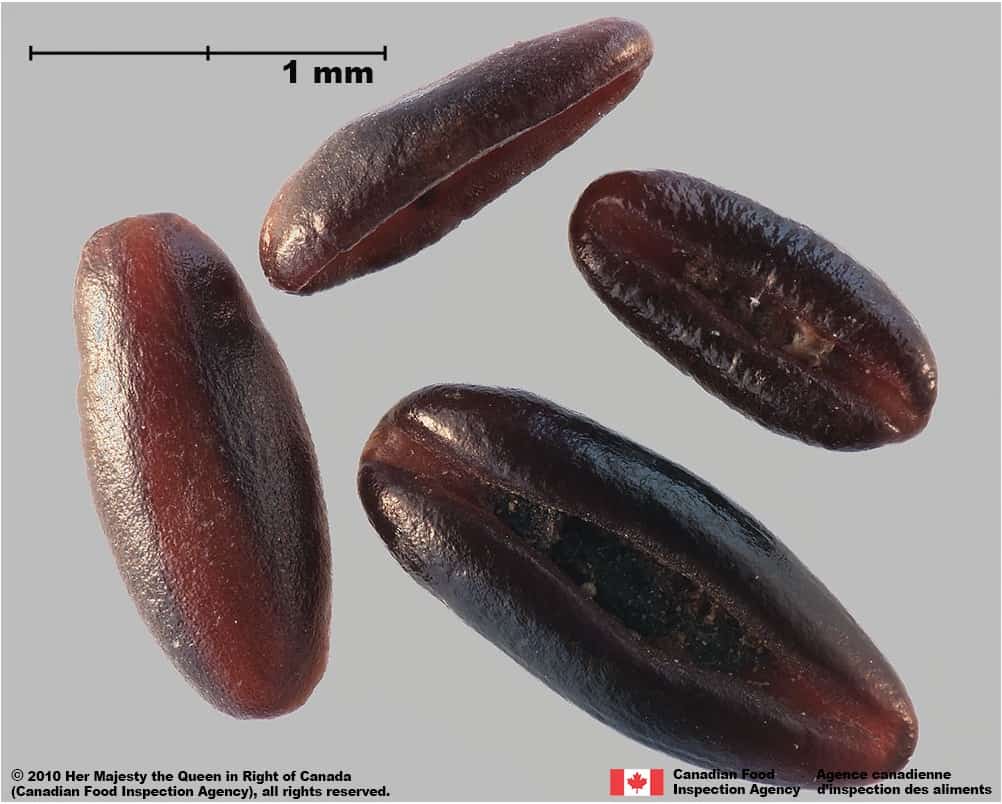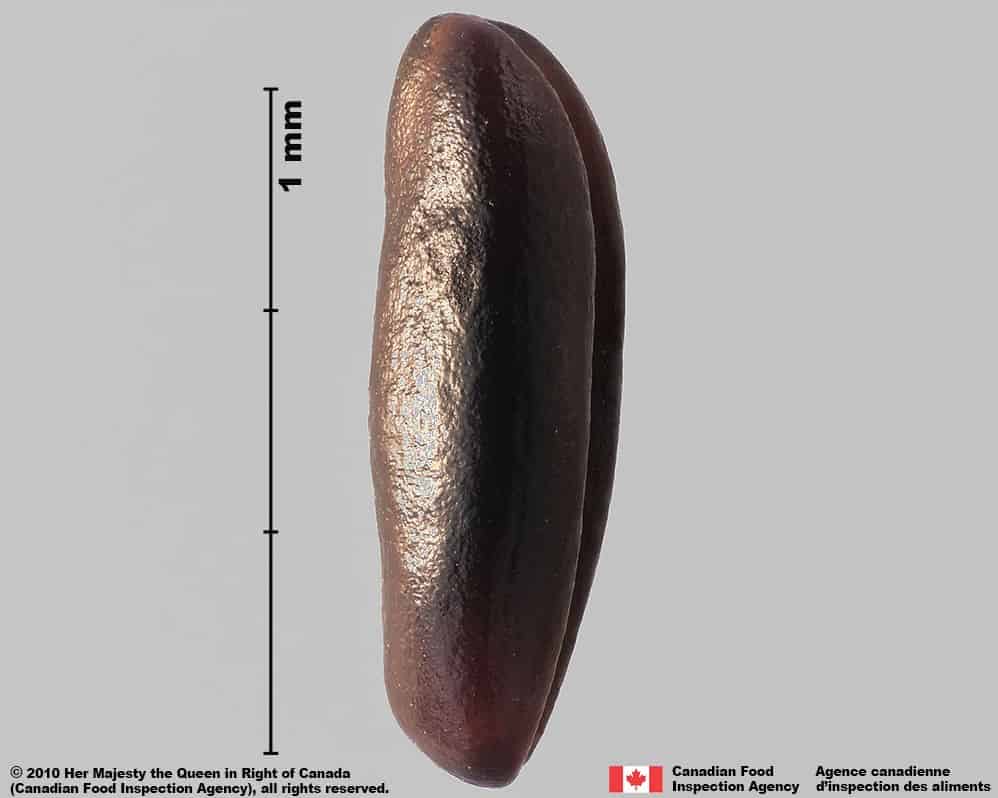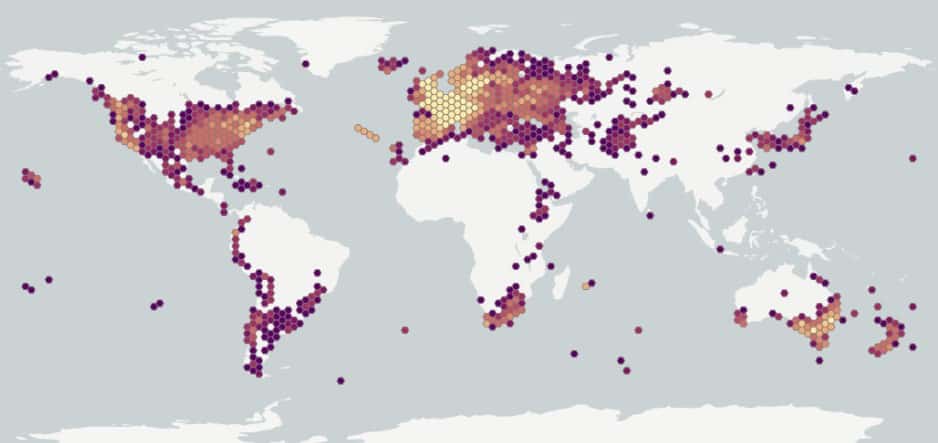Plantago lanceolata
Overview
Aperçu
Regulation :
Remarques Réglementation:
- CFIA Weed Seeds Order - Class 3: Secondary Noxious Weed Seeds
- USA Federal Noxious Weed Seed List
Regulation Notes:
Distribution :
Répartition :
Native to northern Africa, Europe, temperate Asia and south tropical Asia (USDA-ARS 2022). Naturalized in eastern Asia, southern Africa, Australia, New Zealand, North America and South America (CABI 2022; USDA-ARS 2022). Widespread in the United States (USDA-NRCS 2022). Occurs in British Columbia, Manitoba, New Brunswick, Newfoundland, Nova Scotia, Ontario, Quebec and Prince Edward Island (Brouillet et al. 2010+).
Habitat and Crop Association :
Habitat et Cultures Associées :
This species is found in old pastures, hayfields, old fields, forest openings, lawns, railway embankments, roadsides and disturbed areas, especially open dry areas (Cavers et al. 1980; Darbyshire 2003). It is often found in Trifolium spp. (clover) fields, especially T. pratense (red clover) (Cavers et al. 1980).
Economic Use, cultivation area, and Weed Association :
Utilisation économique, zone de culture et association de mauvaises herbes :
Duration of Life Cycle :
Durée du cycle vital:
Perennial
Dispersal Unit Type :
Type d’unité de dispersion :
Seed
General Information
RENSEIGNEMENTS GÉNÉRAUX
P. lanceolata has been associated with European prehistoric people, and moved with them as they migrated (Cavers et al. 1980). It is believed to have come to North America as a crop contaminant, especially in Trifolium species (Cavers et al. 1980). The first report of Plantago lanceolata in North America dates from 1829 in Nova Scotia (Cavers et al. 1980). In New Zealand, cultivars have been developed for forage yield and suitability for livestock grazing (CABI 2022).
P. lanceolata plants have been estimated to produce up to 10,000 seeds without competition, and 60-120 seeds per plant in grasslands (Cavers et al. 1980). The seeds produce mucilage when wetted, and may primarily disperse by sticking to animal fur, bird feathers or machinery (Cavers et al. 1980; CABI 2022). Seeds were found to remain viable when passing through the digestive tracts of animals and birds, and some had enhanced germination (Cavers et al. 1980). Viability of seeds tended to decrease rapidly in a year, but remained viable longer when buried deeply (Cavers et al. 1980).
.
Plantago lanceolata infestation (Forest and Kim Starr, Starr Environmental, Bugwood.org)
Identification
Identification
-
Capsule
Size
- Capsule length: 3- 4 mm (Cavers et al. 1980; Holm et al. 1991)
Shape
- Capsule is oval shaped, inflated in cross section (Cavers et al. 1980)
Surface Texture
- Capsule surface is smooth
Colour
- Capsule is shiny brown coloured
Other Features
- Opens along a transverse line near the middle of the capsule (Cavers et al. 1980)
- Capsule contains 1-2 seeds (Cavers et al. 1980)
-
Seed
Size
- Seed length*: 1.9 – 3.1 mm; width: 0.9 – 1.4 mm
*Note: minimum and maximum of 10 seeds in a normal range of this species using image measurement (ISMA 2020)
Shape
- Seed oblong or occasionally oval, plano-convex in 3 dimensions
- A deep and wide groove is in the centre of the flat side of the seed
Surface Texture
- Seed appears smooth textured, slightly wrinkled under magnification of at least 40x
- A longitudinal ridge of tissue is in the centre of the groove
Colour
- Shiny or glossy translucent brown, dark brown or reddish-brown seed
- Dark-brown coloured tissue generally associated with the hilum
- A light brown, longitudinal stripe is in the centre of the curved side of the seed
Other Features
Hilum and hilum area
- The round hilum is in the middle of the deep groove

Ribgrass (Plantago lanceolata) seeds






-
Embryo
Size
- Embryo partially fills the seed
Shape
- Embryo is spatulate shaped in an axial position (Martin 1946)
Endosperm
- Endosperm is hard and translucent brown coloured
Identification Tips
CONSEILS POUR L’IDENTIFICATION
Members of the Plantago genus in the Plantaginaceae have plano-convex shaped seeds, with a round hilum generally in the middle of the flat side of the seed. The seeds of many species have a central groove on the flat side, species such as P. major and P. rugelii do not have a groove. P. lanceolata seeds, along with many other species, have oval shaped seeds with a translucent colour. This species differs from other oval-shaped seeds by the combination of a glossy brownish colour, no transverse groove around the middle, same size at both ends, and a light brown stripe on the curved side.

Ribgrass (Plantago lanceolata) seed; hilum view






Additional Botany Information
AUTRES RENSEIGNEMENTS BOTANIQUES
Flowers/Inflorescence
- Flowers are collected into an oval shaped or cylindrical flower head 100-450 mm long (Cavers et al. 1980; FNA 1993+)
- Stalk of inflorescence is up to 45 cm long (Cavers et al. 1980)
- P. lanceolata flowers can produce a large amount of pollen that can aggravate allergies (Cavers et al. 1980).
Vegetative Features
- Plants have a short stem, with basal leaves 3-40 cm long (Cavers et al. 1980)
- Leaves are long oval or oblong shaped, generally long-hairy, with smooth or toothed edges (Cavers et al. 1980; FNA 1993+)

Plantago lanceolata flower (John D. Byrd, Mississippi State University, Bugwood.org)




Similar Species
ESPÈCES SEMBLABLES
Similar species are based on a study of seed morphology of various species, and those with similar dispersal units are identified. The study is limited by physical specimen and literature availability at the time of examination, and possibly impacted by the subjectivity of the authors based on their knowledge and experience. Providing similar species information for seed identification is to make users aware of similarities that could possibly result in misidentification.
Plantago arenaria Waldst. & Kit.
P. arenaria grows worldwide, native to Europe and Asia, and naturalized in North America (FNA 1993+; USDA-ARS 2022). The seeds are a similar size as P. lanceolata (length*: 2.1 – 3.2 mm; width: 0.9 – 1.3 mm) are a darker brownish colour, lack the ridge of tissue in the longitudinal groove and on the hilum, and the light brown stripe on the curved side is not as visible as on P. lanceolata seeds.
*Note: minimum and maximum of 10 seeds in a normal range of this species using image measurement (ISMA 2020)
Click to select species
Cliquez pour sélectionner les espèces

Plantago arenaria
Comparison Window
Fenêtre de comparaison
MAIN SPECIES
ESPÈCES PRINCIPALES
Plantago lanceolata

Plantago lanceolata
Plantaginaceae
Ribgrass (Plantago lanceolata) seeds
MAIN SPECIES
ESPÈCES PRINCIPALES
Plantago lanceolata

Plantago lanceolata
Plantaginaceae
Ribgrass (Plantago lanceolata) seeds
MAIN SPECIES
ESPÈCES PRINCIPALES
Plantago lanceolata

Plantago lanceolata
Plantaginaceae
Ribgrass (Plantago lanceolata) seed; hilum view
MAIN SPECIES
ESPÈCES PRINCIPALES
Plantago lanceolata

Plantago lanceolata
Plantaginaceae
Ribgrass (Plantago lanceolata) seed, outer side
MAIN SPECIES
ESPÈCES PRINCIPALES
Plantago lanceolata

Plantago lanceolata
Plantaginaceae
Ribgrass (Plantago lanceolata) seed, side view
MAIN SPECIES
ESPÈCES PRINCIPALES
Plantago lanceolata

Plantago lanceolata
Plantaginaceae
Ribgrass (Plantago lanceolata) seeds, outer side (L) and hilum view (R)
MAIN SPECIES
ESPÈCES PRINCIPALES
Plantago lanceolata

Plantago lanceolata
Plantaginaceae
Ribgrass (Plantago lanceolata) seed, cross-section
SIMILAR SPECIES
ESPÈCES SEMBLABLES
Plantago arenaria

Plantago arenaria
Plantaginaceae
Psyllium (Plantago arenaria) seeds
SIMILAR SPECIES
ESPÈCES SEMBLABLES
Plantago arenaria

Plantago arenaria
Plantaginaceae
Psyllium (Plantago arenaria) seeds
SIMILAR SPECIES
ESPÈCES SEMBLABLES
Plantago arenaria

Plantago arenaria
Plantaginaceae
Psyllium (Plantago arenaria) seed
Need ID Help?
Besoin d’aide pour l’identification?
Reference(s)
Référence(s)
Brouillet, L., Coursol, F., Meades, S. J., Favreau, M., Anions, M., Bélisle, P. and Desmet, P. 2010+. VASCAN, the database of vascular plants of Canada. http://data.canadensys.net/vascan/ Accessed March 10, 2022.
Centre for Agriculture and Bioscience International (CABI). 2022. Invasive Species Compendium, CAB International, Wallingford, UK. https://www.cabidigitallibrary.org/journal/cabicompendium Accessed March 10, 2022.
Cavers, P. B., Bassett, I. J. and Crompton, C. W. 1980. The biology of Canadian weeds. 47. Plantago lanceolata L. Canadian Journal of Plant Science 60: 1269-1282.
Darbyshire, S. J. 2003. Inventory of Canadian Agricultural Weeds. Agriculture and Agri-Food Canada, Research Branch. Ottawa, ON.
Flora of North America (FNA) Editorial Committee, eds. 1993+. Flora of North America North of Mexico [Online]. 22+ vols. New York and Oxford. http://beta.floranorthamerica.org. Accessed December 29, 2022.
Government of Canada (GC). 2016. Canadian Weed Seeds Order. https://laws-lois.justice.gc.ca/eng/regulations/SOR-2016-93/page-2.html (English) https://laws-lois.justice.gc.ca/fra/reglements/DORS-2016-93/page-2.html (French)
Global Biodiversity Information Facility (GBIF) Secretariat. 2022. https://doi.org/10.15468/39omei Accessed via https://www.gbif.org/species/8208358 Accessed December 29, 2022.
Holm, L.G., Plucknett, D.L., Pancho, J.V. and Herberger, J.P. 1991. The World’s Worst Weeds: Distribution and Biology. Krieger Publishing Company, Florida. 609 pp.
International Seed Morphology Association (ISMA). 2020. Method for Seed Size Measurement. Version 1.0. ISMA Publication Guide. https://www.idseed.org/authors/details/method_for_seed_size_measurement.html
Martin, A.C. 1946. The comparative internal morphology of seeds. The American Midland Naturalist 36: 513-660.
Tropicos.org. 2022. Missouri Botanical Garden. https://tropicos.org Accessed March 11, 2022.
U.S. Department of Agriculture-Agricultural Research Services (USDA-ARS). 2022. Germplasm Resources Information Network (GRIN), https://npgsweb.ars-grin.gov/gringlobal/taxon/taxonomysimple.aspx Accessed March 10, 2022.
U.S. Department of Agriculture-Natural Resources Conservation Service (USDA-NRCS). 2022. The PLANTS Database. National Plant Data Team, Greensboro, NC USA. http://plants.usda.gov Accessed June 28, 2022.




